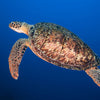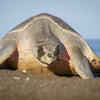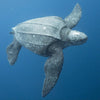The Leatherback Turtle: An Introduction to This Impressive Species

The leatherback sea turtle, also known as Dermochelys coriacea, is one of the largest living species of sea turtle and has adapted to life in the open ocean over the course of evolution. Their unique appearance and behavior have attracted the attention of scientists and nature lovers around the world. In this article we will take a closer look at this impressive species and learn everything there is to know about them.
Appearance
The leatherback sea turtle has a striking appearance with dark, leathery skin and an elongated, slender body. It is the largest of all sea turtles and can grow up to 2.5 meters long and reach a weight of more than 900 kg. The leatherback turtle has a wedge-shaped snout and a distinctive, high arched dorsal line that helps it glide through the water.
The leatherback turtle's shell, unlike other turtle species, is not hard, but elastic and flexible. As a result, it is able to move easily in the water and reach its speed of up to 35 kilometers per hour.
Habitat and distribution
Leatherback turtles live in the warm waters of tropical and subtropical seas worldwide, including the Atlantic, Pacific and Indian Oceans. They prefer open waters and can travel long distances to migrate between breeding sites and feeding grounds.
Lifestyle and Behavior Like all sea turtles, leatherbacks are oviparous, meaning they lay their eggs on land. Females return to the same beaches each year to lay their eggs, which is a remarkable example of navigation and memory. After hatching, the hatchlings dig themselves out of the sand and make their way to the sea. Leatherback turtles are solitary, meaning they live mostly alone except during the mating season.
Diet
Leatherback turtles are omnivores and feed mainly on jellyfish, which they can eat in large quantities. They also have a preference for marine sponges, mollusks and crustaceans. Due to their high food requirements, leatherback turtles are able to consume large amounts of food, making them an important part of the ecosystem. They can consume up to 35% of their body weight in food per day.
Reproduction and nesting behavior
Leatherback turtles are known nest builders and lay their eggs on many beaches around the world. Female leatherback turtles return to their natal sites to lay their own eggs, and they lay up to 100 eggs per clutch. The incubation period of the eggs is about 60 days, and the hatchlings dig themselves out of the sand and make their way to the sea.
Threat and protection
Leatherback sea turtles are threatened with extinction, and their populations have declined sharply in recent decades. The main threats to the species are destruction of nesting sites by human activities, including sand removal and beach pollution, as well as overfishing and loss of food. Another threat is the ingestion of plastic debris, which leatherback turtles may mistake for jellyfish.
There are several protections for leatherback sea turtles, including the U.S. Sea Turtle Conservation Program, which includes establishing hatchery protection zones and reducing fishing activities
Conclusion
The leatherback sea turtle is a unique and impressive species that makes an important contribution to the marine ecosystem. However, it is also threatened by human activities and needs our protection and help to continue to exist in our world. We should strive to minimize threats and take action to promote the protection and conservation of this fascinating species.






